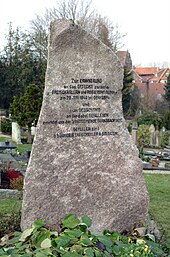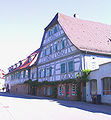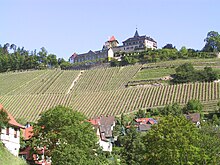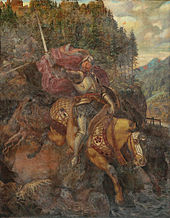Gernsbach
| coat of arms | Germany map | |
|---|---|---|

|
Coordinates: 48 ° 46 ' N , 8 ° 20' E |
|
| Basic data | ||
| State : | Baden-Württemberg | |
| Administrative region : | Karlsruhe | |
| County : | Rastatt | |
| Height : | 174 m above sea level NHN | |
| Area : | 82.09 km 2 | |
| Residents: | 14,296 (Dec. 31, 2018) | |
| Population density : | 174 inhabitants per km 2 | |
| Postal code : | 76593 | |
| Area code : | 07224 | |
| License plate : | RA, bra | |
| Community key : | 08 2 16 017 | |
City administration address : |
Igelbachstrasse 11 76593 Gernsbach |
|
| Website : | ||
| Mayor : | Julian Christ ( SPD ) | |
| Location of the city of Gernsbach in the Rastatt district | ||

The city of Gernsbach is the historic capital of the lower Murg Valley in the Baden-Württemberg district of Rastatt . Together with Gaggenau, it forms a medium-sized center of the Middle Upper Rhine region . The state-approved climatic health resort with a historic old town is the portal community of the Black Forest Central / North Nature Park , a center for the paper industry and a residential community with a surplus of commuters .
Gernsbach, first mentioned in a document in 1219, was founded by the Counts of Eberstein and achieved prosperity through the supra-regional timber trade of the Murgschifferschaft . Due to the decline of the Ebersteiners, who had their seat near the town at Eberstein Castle , Gernsbach was under divided rule or condominium for centuries and became in fact part of the margraviate of Baden in the 16th century . In the 19th century Gernsbach was the administrative city of the Grand Ducal Baden .
geography
Geographical location
The city is located in the northern Black Forest at an altitude of 152 to 988 meters on both sides of the Murg River . The urban area extends from the deeply cut basin of the Murg Valley and its side valleys to the ridges of the Hohloh near Kaltenbronn in the southeast and beyond to some side valleys of the Enz . In the west, the 669 m high mountain cone of the Mercury forms a striking backdrop, in the east the 908 m high mountain Teufelsmühle delimits the valley that opens to the Rhine plain in the northwest .
Spatial planning
The state development plan 2002 counts Gernsbach to the edge zone around the agglomeration of Karlsruhe - Pforzheim . A state development axis is designated through the Murg Valley from Rastatt via Gaggenau and Gernsbach to Freudenstadt . The municipalities of Forbach , Loffenau and Weisenbach also belong to the central area of Gaggenau-Gernsbach . Gernsbach forms together with Weisenbach and Loffenau an agreed administrative community and is their fulfilling municipality.
Expansion of the urban area
The district area of Gernsbach including its districts is 8208.86 hectares. It is mainly characterized by extensive forest areas. 6628.00 ha or 81% of the community area is forest, which is more than twice as much as the state average for Baden-Württemberg. Settlement and traffic areas, at 6%, take up less than half as much space as the national average, while the proportion of agricultural areas at 12% is only slightly more than a quarter of the national average.
City structure
The core town of Gernsbach is divided into the areas to the right of the Murg - with the so-called settlement areas Kelterberg , Entensee , Kolonie and Nord - and Gernsbach to the left of the Murg - with its so-called settlement areas Klingele , Waldbach , Faltergass , Heppeler , Walheimer Hof (incorporated in 1842 ), Stadtbuckel , Siedlung , Hahnbachweg , Panoramaweg and Weinau .
- Coats of arms of the districts
Neighboring municipalities
The following municipalities and cities border the municipality of the city of Gernsbach (clockwise, starting from the northwest):
- to the north: Gaggenau and Loffenau , Rastatt district; Bad Herrenalb and Dobel , district of Calw
- to the east: Bad Wildbad and Enzklösterle , district of Calw
- to the south: Forbach and Weisenbach , Rastatt district
- to the west: Baden-Baden , city district
nature
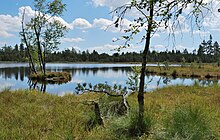
In the 4th order natural spatial structure , the Gernsbach district is divided between the natural areas 151 Grindenschwarzwald and Enzhöhen and 152 Northern Black Forest .
Gernsbach is the portal community of the Black Forest Middle / North Nature Park . More than two thirds of the Gernsbach municipal area are designated as a landscape protection area. The Ice Age raised bogs at over 900 meters above sea level around the Wildsee and Hohlohsee near Kaltenbronn are the largest raised bog area in the Black Forest. They are under protection as a nature and forest reserve Kaltenbronn and are accessible with wooden plank paths. The Kaltenbronn information center , the joint nature park portal for Gernsbach, Bad Wildbad and Enzklösterle, provides information about the nature reserve . The valley floor of Dürreych and Brotenau on the eastern city limits is part of the Eyach- and Rotenbachtal nature reserve .
In several places, the steep slopes around Gernsbach are formed by rocks made of Forbach granite . The area around the Lautenfelsen near Lautenbach is designated as a nature reserve, the Rockertfelsen and Organ rocks are natural monuments .
On the border with Gaggenau-Hörden , Gernsbach has a share in the nature reserve Galgenberg, Favoritenfelsen, Scheibenberg . In 2014, the Hilpertsau nature reserve in the orchard meadows east of the district was designated.
history
Beginnings and city development
A permanent settlement of the Gernsbach district before the 12th century has not been proven. The starting point for the development of the lower Murg valley was the acquisition of the predium (estate) Rotenfels at the entrance to the valley by the noble lords of Eberstein at the beginning of the 12th century as fiefs of the Speyer monastery . From Rotenfels, the Ebersteiners cleared the wooded Murgtal, which was difficult to access due to the swamp of the Murg, and founded new settlements. By around 1200, the Loffenau – Schänen – Gernsbach – Staufenberg line was reached.
In an Eberstein certificate of inheritance from 1219, Gernsbach is first mentioned in writing as Genrespach . At this point in time, a distinction was made between a market village and a church village. The church village, also known as the courtyard , was situated on a terrace to the left of the Murg, south of the Waldbach, on Eberstein allodial property . The church there was the predecessor of today's St. Jacob's Church. The market village on Speyerian fiefdom lay north of the Waldbach on a mountain spur, which offered good conditions for the construction of a city fortification .

The first name as oppidum (city) has been handed down from the year 1243, when the place received its own parish . As with many other city foundations of this era, there is no city census document. The process of becoming a city took decades. In the second half of the 13th century, the people of Eberstein must have moved into Neu-Eberstein Castle above Gernsbach, which is documented as their new ancestral seat in 1272. In addition to the castle, Gernsbach developed into the political and sovereign center of the county, which from the middle of the 13th century expanded its settlement area from here further south to the central Murg valley.
Division and condominium
After a twenty-year feud with Count Eberhard II of Württemberg , Count Wolf von Eberstein had to sell half of the county and half of Neu-Eberstein Castle to Margrave Rudolf VII of Baden in 1387 . This was followed by a period of conflict during the rule divided between the Ebersteiners and the Margraves of Baden , which in 1505 was transferred to a common rule ( condominium ) through the Baden-Eberstein throw- in contract . A joint Vogt was deployed in Gernsbach. In fact, the Eberstein county became part of Baden. This was confirmed by the introduction of the Eberstein regional order in 1508, which was almost identical to the Baden regional order of 1495.
The year 1488 is considered to be the christening year of the Murgschifferschaft , a cooperative of wood merchants and sawmill owners that still exists today as a forestry company, who brought the wood from the Murg Valley to the cities along the Rhine by rafting and was at the center of Gernsbach's economic life. She profited from the decline of the Ebersteiner in 1569, when the indebted Count Philip II sold her his boatman's trade in forests and sawmills in the Murg Valley for 3500 guilders.
Gernsbach suffered destruction from a major fire in 1417 as a result of the Thirty Years War and the War of the Palatinate Succession .
After the male line of Eberstein died out in 1660, Gernsbach came under the administration of three bailiffs : the houses of Baden and Württemberg as well as the prince-bishopric of Speyer each had an office building in the city. In addition, the Counts of Wolkenstein and Gronsfeld, who had acquired property here, tried to gain influence. In 1753 Württemberg ceded its rights to Baden, but it was not until the reorganization of Baden through the Reichsdeputationshauptschluss in 1803 that Gernsbach was again under uniform administration.
19th century
After further city fires in 1787 and 1798 destroyed large parts of the building, the northwest section of the old town was rebuilt according to plans by Friedrich Weinbrenner .
On July 28, 1817, Gernsbach was the starting point for the first ascent with the running machine Draisine of the Baden inventor and forestry teacher Karl Drais to Baden-Baden.
During the Baden Revolution , the rebels built a line of defense on the Murg against the regular troops advancing from the north. On June 29, 1849, there was a battle in Gernsbach , in which numerous houses were destroyed and the federal troops occupied the city.
In 1872 the Gernsbach district office was dissolved and assigned to the Rastatt district office. The city lost its traditional function as an administrative center. Only the district court later moved back to Gernsbach.
On May 31, 1869, the Murgthal Railway Company's railway line from Rastatt to Gernsbach, built mainly at the instigation of the Gernsbach timber industrialist, Murgshipper and Reichstag deputy Casimir Rudolf Katz , was opened. The route was built to keep the Murg Valley timber trade competitive, but then also favored the advancing industrialization of the valley. From 1881 the first paper and cellulose factories were built in and around Gernsbach. An extension of the railway line from Gernsbach to Weisenbach was put into operation on May 1, 1894, and it was not until 1928 that a continuous railway connection through the Murgtal valley to Freudenstadt in Württemberg was established. The rafting industry, which had been important for centuries, continued to decline with the development of traffic routes and the increasing use of water power for energy generation in the 19th century. The last raft went down the Murg in 1896, rafting had been suspended since 1913 and was officially prohibited in 1923.
The rail connection also promoted the development of tourism. The spa park in the Igelbachtal was created in 1874, and Gernsbach was recognized as a climatic health resort in 1884.
Jewish community
Jewish families had lived in the village since at least the late 17th century , and had had a prayer room or a synagogue here by the middle of the 19th century at the latest . The new building at Austraße 3 , which only opened in 1928, was destroyed by SA men in the November pogrom in 1938 , which is now a memorial plaque. Most of the 54 Jews still living in Gernsbach in 1933 emigrated during the Nazi dictatorship or moved to other German cities. At least 13 Jewish citizens of the place were victims of the Shoah . A memorial stone was erected on the city bridge for the nine Gernsbach Jews who were deported to the Gurs internment camp on October 22, 1940 during the Wagner-Bürckel campaign .
Incorporations
Some of the places that in the past had been in the Gernsbach district, which was dissolved in the 19th century, were later incorporated. Chafing started in 1936. Other places were added in the course of the community reform in the 1970s: Staufenberg was incorporated on January 1, 1971. Lautenbach joined on January 1, 1973. Hilpertsau and Obertsrot had already merged on April 1, 1970 to form the municipality of Obertsrot, which was incorporated into Gernsbach on July 1, 1974. With the incorporation of the wooded village of Reichental on January 1, 1975, the Gernsbach district area was more than doubled.
politics
mayor
Mayor Julian Christ (* 1987; SPD ) has been in office since October 1, 2017 and is in his first term. On July 9, 2017, he was voted 83.6 percent in the first round of four applicants. Since an unsuccessful competitor against the validity of the election unsuccessfully appealed to the Administrative Court in Karlsruhe had submitted, Christian worked as Temporary Administrator operates and has been committed until June 25, 2018 as mayor. He is the successor of the previous mayor Dieter Knittel (SPD), who did not stand for election after three terms in office.
Municipal council
According to the local elections on May 26, 2019 , the Gernsbach municipal council - in addition to the mayor as chairman - has 29 members. The choice brought the following result:
Town twinning
Gernsbach has had a partnership with Baccarat in Lorraine , France , since 1965 . In addition, on May 1, 2010, there was another city partnership with Pergola in Italy.
Culture and sights
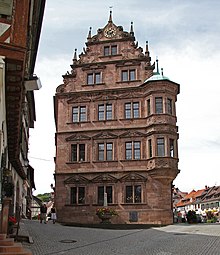
Buildings
The historical Gernsbach town center has been a listed building as a whole since 1983 . This includes the area within the medieval city walls including the upper town around the Liebfrauenkirche, the courtyard, the buildings on the Waldbach, in the Schloßstraße and around the St. Jakobskirche as well as the suburb east of the Murg on Bleichstraße and Igelbachstraße. Over 400 buildings in Gernsbach are listed.
In the old town, a mountain killing - from Gern Bachern city mogul called - go up, numerous interesting buildings and ensembles have survived. During the city fires of 1787 and 1798, the gable-facing Gothic buildings that were built after the devastating city fire of 1417 were lost. The vaulted cellars of the medieval predecessor buildings can still be found under today's buildings in the old town, which were built during the Baroque and Classicism periods.
- Written evidence of a Gernsbach city fortification has existed since the middle of the 14th century. The city wall , which was once around 900 meters long , has been partially torn down since the beginning of the 19th century in order to allow the city to expand. Its course can still be read today in the cityscape, parts are still there. In the area between Waldbachstrasse and Amtsstrasse, a section was restored and the outer kennel wall restored.
- The stork tower is one of the landmarks of Gernsbach and was part of the city fortifications. There were other watchtowers at Färbertor, Storrentor and Untertor, which were demolished around 1800 and 1960.
- The pillars and pilasters of the Kornhaus , which was rebuilt by Friedrich Weinbrenner after the town fire in 1798, were made from the stones of the Färbertorturm . The previous building served as a butcher and town hall well into the 18th century . The school was housed in it around 1900.
- A historically significant building is the old town hall with its richly decorated sandstone façades, which was built in 1617–1618 in the Mannerist style as a residential palace for the wealthy forest owner, timber merchant and Rhine and Murgshipper Johann Jakob Kast . The name Old Town Hall refers to the time when the city administration moved into the building in the 18th century, where it carried out its official business until 1936. The name of the builder has not been passed down. Based on comparisons of the formal language with that of the Friedrichsbau in Heidelberg Castle , Johannes Schoch is accepted as the master builder of the Old Town Hall. Since April 2012, the building has been the seat of the Jan Brauers Foundation for Progress through Harmony and the Museum of Harmony , which shows parts of Jan Brauers' private collection .
- The catholic parish church of Our Lady (Liebfrauenkirche) , visible from afar, stands at the highest point in the old town. Today's church tower goes back to a medieval defense tower and was part of the city fortifications. Well-known expansions of the church date from 1388 and 1833. In 1970 and 1971 the church was extensively renovated both inside and outside and especially inside the high Gothic parts of the architecture worked out and damage removed. The new structural components were made of exposed concrete.
- The Protestant Church of St. James - built from 1467 to 1471 on the site of an older previous building, the first Gernsbach Church; with alterations from the 18th century.
- The Hofstätte - historical buildings in half-timbered and Wilhelminian style surround the square that forms the entrance to Gernsbach's old town. The two oldest inns in the city, the Stern & Hirsch and the Traube , are left of what were once six in this residential and business district.
- The Alte Amtshof - Franconian half-timbered building built around 1556 as a Speyer office cellar , from 1661 to 1673 the seat of the Speyer magistrate.
- The historic tithe barns are enthroned on the city wall between Waldbachstrasse and Amtsstrasse . The medieval battlement can still be walked on in the barns today. The outer and inner city wall ring extends from the tithe barn within the neighboring buildings to the Gleisle area. The Forum Gernsbacher Zehntschänen eV is endeavoring for the future preparation and a cultural use of the Zehntschänen.
- The building of the butcher shop Gleisle at Hauptstrasse 6, the square is known as the Gleisle area , was demolished in 1994 and 2008. As a result, a 42 meter long and four meter high section of the historic city wall came to light, and the Zwinger is freely accessible.
- Eberstein Castle - before 1272, the former seat of the counts of the extinct family of the Counts of Eberstein , then until the recent past margravial Baden property, private property since 2000 and today used as a hotel, restaurant and winery. Also with modifications by Friedrich Weinbrenner.
- The Kaiser Wilhelm Tower on the Hohloh , also known as the Hohlohturm , was built in 1897 as an observation tower near the highest point in what is now the Gernsbach urban area. You are on its platform at an altitude of over 1000 m above sea level. NN .
Waldbachstrasse and Liebfrauenkirche
The stork tower
movie theater
The Gernsbacher Globus-Kino was built in 1954 and 1955 as a municipal project with one of the largest cinema halls in Mittelbaden, which in the 1980s was subdivided into a so-called cinema center with the Globus and Atlantis cinemas . On September 1, 2010, the building was entered in the Baden-Württemberg state's list of monuments as an exemplary movie theater from the early post-war period. The foyer with its wall mosaics, which allegorically treat the name of the Globus cinema, is particularly worthy of protection . The cinema was the location of the ARD television series Atlantis Must Not Go Down in 1988.
Parks
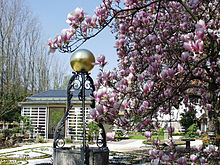
- The Katz'sche Garten - a formerly private late baroque garden of the wealthy Katz family, with a collection of art monuments, some of which date from the late Gothic, Renaissance, Baroque and Art Nouveau periods.
- The spa park in the Igelbachtal has lawns with old trees, swan ponds and a concert stage for open-air performances.
Hiking trails
An extensive network of hiking trails extends over the municipality. The Gernsbacher Runde and Gernsbacher Sagenweg hiking trails and the Murgleiter long-distance hiking trail to Baiersbronn have been awarded the German Hiking Seal rating by the German Hiking Institute . The north-south long-distance hiking trails through the Black Forest Westweg and Mittelweg run in the Gernsbacher Höhengebiet via Kaltenbronn and the Hohloh. The Ortenau Wine Trail themed hiking trail , which is over a hundred kilometers long, begins at the Old Town Hall . The Murg Valley hiking trail follows the course of the Murg . The sculpture path Kunstweg am Reichenbach connects Hilpertsau and Reichental. The Arboretum Schloss Eberstein is an arborist educational trail.
Regular events
- Gernsbacher Altstadtfest - The city festival , known far beyond the city limits, is a meeting point for locals and guests from near and far. It takes place every year on the third weekend in September, in 2018 with the 43rd edition. In 2019, on the occasion of the city's 800th birthday, it will be canceled in favor of an anniversary celebration on July 12th to 14th. In 1974 the old town festival was initiated by the then mayor Rolf Wehrle, as an expression of the joy about the renovation of the bridge mill, the most unsightly building at the entrance to the old town, by its owner.
- Gernsbach Christmas market - every second weekend in December in the historic old town.
- Gernsbach Puppet Theater Week - Also every year there is a performance meeting of puppet stages and players from Germany and Austria. The performances cover topics for all age structures and from all areas, such as the dramaturgy from literature, fairy tales and modernity. The period of the performances is in the weeks before Easter. The festival venue is the town hall. The 31st Puppet Theater Week took place in April 2019.
- Gernsbach Convention of the Wingolfsbund - the Wingolfs connections of the Wingolfsbund from South Hesse, Rhineland-Palatinate, Baden-Württemberg and Munich traditionally meet every two years for the so-called Little Wartburg Festival in Gernsbach. The Wingolfs connections are Christian, non-striking connections.
- Schlossberg – Historic - A motorsport event for so-called oldtimer and youngtimer vehicles, which is organized by the local motorsport association Automobilclub AC Eberstein e. V. , based on the long mountain racing tradition of the former Schloßberg race , is held annually in spring from the Murginsel.
- Hockey Whitsun tournament of the Hockey Club Gernsbach 1919 e. V. - A traditional hockey sport event known throughout Germany by field hockey experts, which was held for the 71st time in 2018.
- Ice pond model ship frigatta of the ship model club Murgtal e. V. - An exhibition and regatta event known far beyond Gernsbach for model ship fans, which takes place every year on May 1st at the Eisweiher.
- Theater im Kurpark - Since the beginning of the 1990s, a young theater ensemble of the same name has been performing a series of classical pieces every year in the Kurpark during the summer. There will be eight events during the summer months. The theater group has performed classics such as B. Julius Caesar , Jedermann or Faust .
Economy and Infrastructure
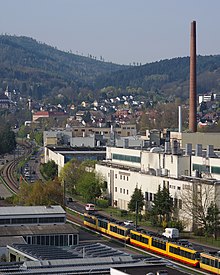
traffic
Road traffic
Gernsbach is located on federal highway 462 , which is also the connection to the next motorway junction, Rastatt-Nord (No. 49) on federal motorway 5 Karlsruhe-Basel. The distance from Gernsbach-Nord to the A5 is about 13 km, of which about 7 km is a four-lane expressway . On this section, a test track for trucks will be set up that can be operated electrically via an overhead line.
The B 462 has been crossing under the city center since 1997 in the 1527 m long Gernsbach tunnel .
Rail and bus transport
The Murg Valley Railway has been electrified since 2003 and is operated by Albtal-Verkehrs-Gesellschaft mbH (AVG) and is integrated into the regional public transport network of the Karlsruhe Transport Association (KVV). Gernsbach has thus a direct, in clock transport operated light rail connection to the center of Karlsruhe . The public bus routes operated by Regionalbusverkehr Südwest GmbH (RVS) , including to Baden-Baden, Bad Herrenalb and Kaltenbronn, are also organized in the KVV tariff association.
Paper and cardboard industry
Gernsbach, also known as the papermaking town , is the center of the paper and cardboard processing industry in the Murg Valley. Since the 1880s, the middle Murgtal has become a core area of industrial paper production in Germany due to its abundance of wood and the existing water power.
Resident companies in the paper, cardboard and packaging industries
- Glatfelter Gernsbach GmbH (formerly Schoeller & Hoesch ). The plant, located between Bundesstraße 462 and the Murg, is the largest employer in Gernsbach with around 600 employees (2010). Among other things, overlay paper , teabag and coffee filter paper and metallized paper are manufactured.
- Mayr-Melnhof GmbH & Co. KG , Gernsbach-Obertsrot produces recycled cardboard.
- Baden Karton, Gernsbach-Obertsrot produces folding boxboard.
- Casimir Kast Packaging and Display GmbH, Gernsbach-Schänen.
Gernsbach paper center
Due to the accumulation of manufacturers and processors in the region, the Gernsbach paper center is located here . It emerged from the first and then only institution for vocational training in the German paper industry called the Gernsbach paper maker school, founded in 1956 . This is now part of the center and is supported by the Rastatt district as a state institution. The headquarters of the Baden-Württemberg paper associations and other academies financed by the paper industry are also located in the building complex. The center is one of the most important national and international training and further education institutions for specialists in the paper, cardboard and cellulose industry. The name Gernsbacher Meister is an internationally known industry quality term for graduates of this institution.
Other industries
- Röchling Automotive KG , Gernsbach plant is a company in the automotive supplier industry.
Viticulture
Gernsbach is a wine-growing town in the Ortenau wine-growing region , which is part of the Baden wine-growing region . Wine -growing businesses located here are the Iselin winery with its 5- hectare Staufenberger Großenberg vineyard and headquarters in the Old Town Hall, as well as the Schloss Eberstein winery with 7 hectares of vineyards on the southern slopes below the castle. An alternative route on the Baden Wine Route leads via Gernsbach. In addition, field and street names such as Weinau and Weinbergstrasse indicate the historical importance of viticulture in Gernsbach.
Hospitality
In Gernsbach around 740 guest beds are offered in hotels, guest houses and private quarters, which were used in 2007 for over 100,000 overnight stays.
With the editions of the hotel and restaurant guides Guide Michelin and Gault Millau , Edition Germany 2007, Gernsbach was also mentioned for the first time in the field of top gastronomy. Chef Matthias Schormann in Werner's Restaurant at Schloss Eberstein received a star in the Michelin Guide and was awarded 16 (out of 20) points and two (out of four) toques by Gault Millau.
media
The daily newspapers Badisches Tagblatt (BT) based in Baden-Baden / local editorial office Gaggenau and their local edition Der Murgtäler and the Badische Latest News (BNN) - based in Karlsruhe / local editorial office Gaggenau - report on local events in Gernsbach and the Murg Valley - with the local edition Rastatt / Gaggenau .
The Badischer Tagblatt publishes two advertising and local business news journals called Wochenjournal WO - Murgtal edition and WO am Sonntag - Rastatt / Murgtal edition, which are sent to households free of charge.
The Gernsbacher Stadtanzeiger serves, among other things, as an official bulletin and is distributed once a week free of charge to Gernsbach households with a circulation of around 6,900 copies. It is being relocated by Nussbaum Medien , based in Weil der Stadt , which has an external office in the neighboring town of Gaggenau.
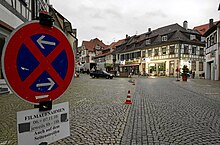
The Casimir-Katz-Verlag , founded by Casimir Katz in Gernsbach, publishes literature on the program focus on history and biographies. The publisher publishes the quarterly magazine Gernsbacher Bote , the majority of which contains articles on the city's history and a circulation of around 7,800 copies is distributed free to households. In Gernsbach, Katz developed the European Economic Service (EUWID) from its small beginnings into an important industry information service and established the Deutsche Betriebswirte-Verlag here .
Gernsbach has repeatedly been the scene of film and television productions. As early as 1933, the city was the location of the film Heimkehr ins Glück with Heinz Rühmann , which contains views of Gernsbach city center, the surrounding villages and the Murg Valley. The Südwestrundfunk from neighboring Baden-Baden shot here several times for its crime scenes . In the old town, scenes were created for the movie 25 km / h (2018), the television films Vom Küssen und vom Flug (2000) and Carl & Bertha (2011) as well as for the series Der Schwarzwaldhof . Some settings of the ZDF film Die Holzbaronin , which was made in 2012 based on the novel Die Holzbarone by Gernsbach's Casimir Katz, were shot in the old town. Reichental is the location of television productions such as Die Fallers and Die indische Ärztin (broadcast 1994–1996).
District Court
Gernsbach is the seat of a local court that belongs to the regional court district of Baden-Baden and the higher regional court of Karlsruhe. The district court district includes the communities Forbach, Gernsbach, Loffenau and Weisenbach. After the Gernsbach District Office was abolished in 1872, the court was reinstated in 1878.
Healthcare
The MediClin Rehabilitation Center Gernsbach is a specialist clinic for cardiovascular, vascular and orthopedic diseases opened in 1998. Kraichgau Klinik AG, which was taken over by MediClin AG at the end of 2007, built the new building in Weinau. The clinic for geriatric rehabilitation set up in the former Gernsbach district hospital also became the sponsorship of MediClin in 2011; a specialist neurology clinic was established in the building.
A leprosy or manor house near the Jakobskirche was mentioned in a document as early as 1467 . In 1511 a hospital was built to the right of the Murg, immediately south of the Murg Bridge. After it was destroyed by floods in 1824, a new building was built in the suburb of Waldbach in 1832–1838. In 1902, with the new hospital building in Casimir-Katz-Straße, the nucleus of the later (from 1959) district hospital, which had 120 beds after the construction of a ward from 1966–1968.
education
Gernsbach is a middle school center. In 2007/2008, 1,912 pupils were taught here in general schools. In addition to the primary schools in the Hilpertsau, Staufenberg and Schänen districts, the community school is located in the city center on the left of the Murg. The secondary school , the Albert-Schweitzer-Gymnasium , the Gernsbach commercial college and the Murgtal music school, jointly supported by the city of Gernsbach and the communities of Loffenau , Weisenbach and Forbach , are also located there . The Gernsbach papermaking school is a nationally important commercial vocational and state technical school (master school), see section paper and cardboard industry . The paper Gernsbach is also the headquarters of the bachelor's degree program Papiertechnik the Duale Hochschule Baden-Württemberg Karlsruhe .
The Albert-Schweitzer-Gymnasium Gernsbach has had this name since 2003 and has been housed in a new building on a hillside since 1969. It emerged in 1967 from a Progymnasium created in 1947 , the successor to the educational institutions previously existing in Gernsbach as Realgymnasium (1873), Higher Citizens School (1839) or Latin School (officially recognized as a middle school in 1828).
Personalities
sons and daughters of the town
- Jacob Montanus (around 1460–1534), Protestant theologian, humanist and reformer
- Joseph von Lassolaye (1746–1822), governor of the County of Eberstein, district director and councilor, first honorary citizen of Baden-Baden
- Johann Heinrich David von Hennenhofer (1793–1850), Baden diplomat and wing adjutant, was associated with the alleged murder of Kaspar Hauser
- Friedrich von Drais (1798–1883), Baden head forester, later Benedictine
- Alfred von Degenfeld (1816–1888), Prussian lieutenant general, member of the Reichstag
- Karl Friedrich Moest (1838–1923), sculptor
- Ludwig Dill (1848–1940), painter
- Ernst Kräuter (1855–1915), born in Obertsrot, Feilenhauer, member of the Baden state parliament
- Casimir Otto Katz (1856–1919), industrialist and honorary citizen of Gernsbach
- Eugen Isaak Neter (1876–1966), pediatrician and head of the Jewish community in Mannheim
- Karl Emil Schabinger von Schowingen (1877–1967), diplomat and head of the intelligence agency for the Orient
- August Meier (1885–1976), SPD local politician and honorary citizen of Nuremberg
- Walther Eichrodt (1890–1978), Protestant theologian and Old Testament scholar
- Karl “Charlie” Kappler (1891–1962), the most successful German racing car driver of the 1920s
- Georg Menges (* 1923), professor and pioneer of plastics technology
- Kurt Sontheimer (1928–2005), political scientist
- Erich Kleinschmidt (* 1946), philologist and university professor
- Ute Verhoolen (1948–2013), presenter and TV announcer for ARD at Südwestfunk
- Ulla Brede-Hoffmann (* 1950), politician (SPD)
- Thomas Wehrle (* 1964), SWR / ARD sports journalist
- Michael Felder (1966–2012), priest and theologian
- Thomas Baier (* 1967), classical philologist
- Sylvia Felder (* 1967), politician (CDU), district president of the Karlsruhe district
- Georg Ackermann (* 1972), athlete
- Angela Schirò (* 1985), German-Italian parliamentarian
- Steffen Sontheimer (* 1990), poker player
Other well-known personalities in Gernsbach

- Wolf von Eberstein (around 1340–1396), lost his property due to a feud with the House of Württemberg and went down in literature and legends
- Wilhelm IV. Von Eberstein (1497–1562), officially introduced the Reformation in 1556 in the county of Eberstein
- Ernst Ludwig Posselt (1763–1804), historian, since 1791 bailiff in Gernsbach, resigned this office in 1796 out of sympathy for the ideas of the French Revolution
- Georg von Drais (1758–1833), studied forest master and uncle of the inventor, ran his private forestry school here until 1798 and introduced the larch tree in the Black Forest
- Karl Drais (1785–1851), studied forestry teacher and inventor, lived here in 1794 and started the ascent from Gernsbach on his running machine to Baden-Baden on July 28, 1817 (second two-wheeler ride in history)
- Casimir Rudolf Katz (1824–1880), timber industrialist, debris builder and member of the Reichstag
- Gottlieb Klumpp (1829–1918), timber merchant and member of the Reichstag
- Heinrich Funck (1853–1932), philologist and historian, director of the high school in Gernsbach
- Georg Menges (1888–1973), mayor 1919–1933, local and state politician from Baden and Baden-Württemberg
- Walter Frevert (1897–1962), forester and hunting writer
- Oka Barthold (1904–1980), puppeteer, painter and graphic artist
- Scipio Colombo (1910–2002), Italian baritone
- Heinz Schimmelpfennig (1919–2010), actor and radio play speaker, known as Tatort - Commissioner Gerber of the SWF
- Heinz Herrmannsdörfer (1923–1999), German musician, arranger and composer
- Casimir Katz (1925–2008), entrepreneur and publisher
- Otto Birg (1926–2015), painter, draftsman and sculptor
- Peter W. Jansen (1930–2008), journalist and film critic
- Otmar Zwiebelhofer (1935–2014), entrepreneur and business leader
- Rick Abao (1939–2002), American jazz musician, composer and entertainer, lived in Gernsbach since 1989
- Andreas Birkmann (* 1939), former federal judge D., Thuringian Minister of Justice a. D.
- Hans-Christoph Graf von Nayhauss (* 1940), literary and cultural scientist
- Immo Vogel , journalist, former chief correspondent and international head of the SWR, moderator of the ARD magazine Weltspiegel and Europamagazin as productions of the SWF / SWR
- Jenny Abel , violinist
- Andreas Cathedral (1955-2014), SWF3 spokesman and inventor of SWF3 comedy figure Werner Chibulsky , author, journalist and SWR1 presenter
- Wolfhard Pencz (* 1957), solo clarinetist in the SWR Symphony Orchestra Baden-Baden and Freiburg , professor at the Mannheim University of Music and Performing Arts
- Bernd Werner , restaurateur at Schloss Eberstein, culinary organizer of the Bambi media award ceremony
- Thomas Hentschel , politician (Greens), member of the state parliament of Baden-Württemberg since August 2016 ; Municipal council in Gernsbach
- Christoph Azone (* 1967 as Christoph Gieser), journalist and moderator, grew up in Gernsbach
- Nadja Einzmann (* 1974), writer, grew up in Gernsbach
literature
- City of Gernsbach, Wolfgang Froese (ed.): 800 years of Gernsbach - The history of the city. Casimir Katz Verlag, Gernsbach 2019, ISBN 978-3-938047-75-0 .
- Rainer Hennl: Gernsbach im Murgtal - structures and developments up to the end of the Baden-Eberstein condominium in 1660. W. Kohlhammer Verlag, Stuttgart 2006, ISBN 3-17-019480-1 .
- Max Scheifele : The Murgschifferschaft - history of the raft trade, the forest and the timber industry in the Murg Valley. Casimir Katz Verlag, Gernsbach 1988, ISBN 3-925825-20-7 .
- State archives office Baden-Württemberg, district Rastatt and state media center Baden-Württemberg (ed.): District descriptions of the state of Baden-Württemberg - The district of Rastatt. Volume 2, Jan Thorbecke Verlag, Stuttgart 2002, ISBN 3-7995-1364-7 , pp. 79-152.
Individual evidence
- ↑ State Statistical Office Baden-Württemberg - Population by nationality and gender on December 31, 2018 (CSV file) ( help on this ).
- ^ Gernsbach in the regional information system for Baden-Württemberg LEO BW, accessed on April 25, 2014
- ↑ State Development Plan 2002 Baden-Württemberg , p. A17 (PDF; 8.05 MB). Retrieved October 12, 2016
- ↑ a b c Statistics Kommunal 2008 - Gernsbach (PDF; 1.4 MB) ( Memento from December 8, 2015 in the Internet Archive )
- ↑ Natural areas of Baden-Württemberg (PDF; 3 MB), State Institute for the Environment, Measurements and Nature Conservation Baden-Württemberg, accessed on September 11, 2012
- ↑ Hennl: Gernsbach. 2006, p. 30 ff.
- ↑ Hennl: Gernsbach. 2006, p. 38.
- ↑ Rainer Hennl: introduction of ebersteinischen Landesordnung. In: Gernsbacher Bote, No. 1, 2008, pp. 5–6. Online version (PDF; 1.9 MB)
- ^ Scheifele: Murgschifferschaft. 1988, p. 179.
- ↑ Hennl: Gernsbach. 2006, p. 84.
- ↑ Alemannia Judaica: Gernsbach: Jüdische Geschichte / Prayer Hall / Synagoge , queried on December 25, 2008
- ↑ Memorial sites for the victims of National Socialism. A documentation. Vol. I, Bonn 1995, ISBN 3-89331-208-0 , p. 39.
- ^ Federal Statistical Office (ed.): Historical municipality directory for the Federal Republic of Germany. Name, border and key number changes in municipalities, counties and administrative districts from May 27, 1970 to December 31, 1982 . W. Kohlhammer, Stuttgart / Mainz 1983, ISBN 3-17-003263-1 , p. 501 .
- ^ Federal Statistical Office (ed.): Historical municipality directory for the Federal Republic of Germany. Name, border and key number changes in municipalities, counties and administrative districts from May 27, 1970 to December 31, 1982 . W. Kohlhammer, Stuttgart / Mainz 1983, ISBN 3-17-003263-1 , p. 483 .
- ^ Thomas Dorscheid: landslide victory for Julian Christ , Badische Latest Nachrichten , July 9, 2017
- ↑ Christian now fully in office and dignity. In: Badisches Tagblatt, Der Murgtäler from June 26, 2018.
- ↑ Municipal Council. City of Gernsbach, accessed on July 25, 2019 .
- ↑ Municipal council elections 2019 - Preliminary results of the municipal council elections 2019 with comparative information from 2014 - City of Gernsbach. State Statistical Office of Baden-Württemberg, accessed on July 25, 2019 .
- ↑ Monument protection. In: gernsbach.de. City of Gernsbach, accessed on August 17, 2017 .
- ↑ H / Gernsbach No. 2 and No. 7, 1798 and 1787. Generallandesarchiv Karlsruhe
- ^ Landesarchivdirektion Baden-Württemberg, Landkreis Rastatt and Landesmedienzentrum Baden-Württemberg (ed.): District descriptions of the state of Baden-Württemberg - The district of Rastatt. Volume 2, Jan Thorbecke Verlag, Stuttgart 2002, ISBN 3-7995-1364-7 , p. 95.
- ^ Clemens Kieser, Karlfriedrich Ohr, Wolfgang Stopfel, Martin Walter: Art and cultural monuments in the Rastatt district and in Baden-Baden. Konrad-Theiss Verlag, Stuttgart 2002, ISBN 3-8062-1599-5 , p. 208.
- ↑ Manuela Dessau: Gernsbach and his old town hall. Elster Verlag, Bühl-Moos 1984, ISBN 3-89151-002-0 .
- ^ Museum of Harmony . The main contingent of this private collection went to the German Museum of Music Automatons in Bruchsal Castle.
- ^ Heinz Gaiser: Liebfrauenkirche Gernsbach. Schnell und Steiner publishing house, Munich / Zurich 1973
- ↑ Volker Neuwald: The Gernsbacher Cinema - a cultural monument. In: Badisches Tagblatt . No. 218, The Murgtäler. from September 20, 2011.
- ↑ Hiking in and around Gernsbach. City of Gernsbach, accessed on February 11, 2018 .
- ↑ Gernsbach Old Town Festival. City of Gernsbach, accessed on January 11, 2019 .
- ↑ City of Gernsbach: Puppet Theater Week
- ↑ The new Michelin Guide 2007 for Germany goes on sale. In: Michelin.de. Michelin Reifenwerke AG & Co. KGaA, November 20, 2006, archived from the original on January 1, 2011 ; Retrieved December 3, 2015 .
- ↑ Press release from Gault Millau Verlag - Presentation of the Baden-Württemberg 2007 restaurant awards ( Memento from May 21, 2007 in the Internet Archive )
- ↑ Hennl: Gernsbach. 2006, p. 66.
- ↑ Bachelor of Engineering - Paper Technology. Paper center Gernsbach, accessed on November 12, 2018 .
- ^ Landesarchivdirektion Baden-Württemberg, Landkreis Rastatt and Landesmedienzentrum Baden-Württemberg (ed.): District descriptions of the state of Baden-Württemberg - The district of Rastatt. Volume 2, Jan Thorbecke Verlag, Stuttgart 2002, ISBN 3-7995-1364-7 , p. 148.
- ↑ Albert-Schweitzer-Gymnasium (Ed.): 175 years of the Gernsbach Gymnasium. Festschrift, Gernsbach 2003, pp. 12-14.
Web links
- Link catalog on Gernsbach at curlie.org (formerly DMOZ )
- City of Gernsbach







